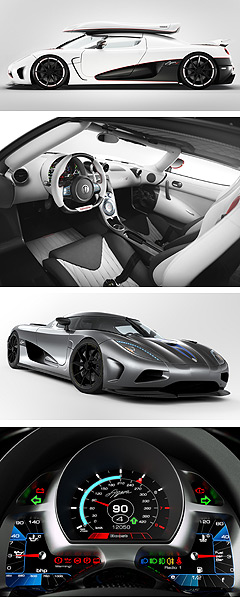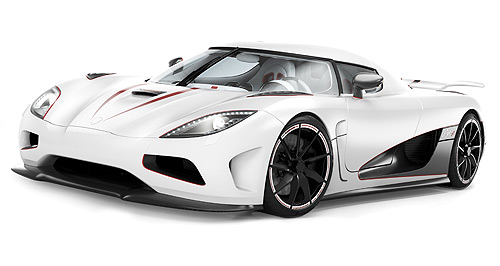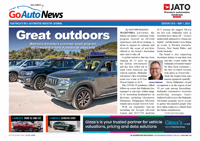Make / Model Search
Future models - Koenigsegg - Agera - RGeneva show: Koenigsegg's Bugatti-busting Agera RHyper: With 820kW on tap, the tail-lights will be the thing most people see on the Swedish hypercar. Koenigsegg’s bonkers 420km/h Agera R runs on bio fuel and has a roof box2 Mar 2011 SELF-STYLED ‘hypercar’ maker Koenigsegg used this week’s Geneva show to present production versions of its Agera and top-spec Agera R ultra high-performance cars. The Swedish sportscar specialist supplied a smorgasbord of staggering statistics including a peak power and torque outputs of 820kW and 1200Nm from its in-house developed aluminium and carbon-fibre 5.0-litre twin-turbo V8 when running on bio-ethanol based E85 fuel. The Agera R’s power and aerodynamics point to a theoretical top speed of 440km/h and the car has a dry weight of 1330kg – about the same as a Mazda 3. The outrageous performance is achieved by a Euro 5-compliant engine that runs best on eco-friendly bio fuel, emits 310 grams per kilometre of CO2 and consumes 14.7 litres of fuel per 100 kilometres according to official EU figures. That fuel consumption figure compares with Ford’s old Falcon XR8 and makes Lamborbhini’s Aventador look thirsty and polluting with its 17.2l/100km and 398g/km. But to be fair to the Raging Bull, its products don’t occupy the same pricing league as the Agera, which costs an estimated US$2.1 million – plus quite a bit more for the R.  Left: Agera R complete with roof box, and Agera R interior. Bottom: The 'standard' Agera. Left: Agera R complete with roof box, and Agera R interior. Bottom: The 'standard' Agera.Despite the Bugatti-busting theoretical top speed, Ageras are electronically limited to 375km/h. Koenigsegg will however disable the governor for short periods of time if road, tyre and engine conditions are deemed appropriate. Ageras come fitted with specially-developed Michelin tyres that are said to offer cup tyre levels of grip, “outstanding” wet weather performance and are rated for speeds over 420km/h – which the company claims is the world’s highest top speed rating for any road tyre. The thunderous power and torque is fed to the rear wheels by an all-new seven-speed dual-clutch transmission which weighs just 81kg and unlike conventional dual-clutch systems, has a single input shaft meaning fewer moving parts, smaller size and low weight. By incorporating a traditional limited-slip differential with a high-tech E-Diff, Koenigsegg claims to have developed one of the lightest and fastest systems on the market, which is used with what it says is the industry’s fastest reacting traction control system to ensure high levels of stability and grip. The Agera’s suspension uses F1-style long wishbones and a third spring and damper unit connects the rear wheels to prevent the car squatting under hard acceleration while also enabling the spring and damper rates of the main suspension units to be lowered, increasing ride comfort and improving rough- and wet-road handling. The Agera’s rear wing is designed to use wind resistance rather than electronics or hydraulics to change shape for optimum performance at a given speed. Meanwhile, the spokes of the alloy wheels are designed to act as turbine blades that suck air from beneath the car, simultaneously cooling the brakes and increasing downforce. The Agera’s interior of leather, alcantara, carbon fibre and exquisite metals features aluminium buttons with tiny holes drilled in them so that when the LED backlight is applied, the symbol appears seemingly out of nowhere. Unusually for a car of this type, there is a 120-litre luggage space sufficient to store a set of golf clubs or the car’s detachable roof. The Agera R on display at Geneva, a customer car, further increases practicality with the addition of a Thule-branded carbon-fibre roof box containing skiing equipment. Koenigsegg says this is the world’s fastest roofbox, rated up to 300km/h. In the spirit of thoughtful touches the Swedes are famous for, the Agera features an intelligent battery system that always ensures enough charge will be available to start the engine, regardless of whether the driver left the lights or the entertainment system switched on when they parked up for the night. It works using a new type of battery that does not require a trickle charger to prevent draining – Koenigsegg appreciates that many cars of this type find themselves parked for long periods of time – coupled with a self-shutdown system that automatically turns equipment off when the battery voltage reaches a pre-determined level.  Read moreAll motor show Alfa Romeo Alfa Romeo Abarth Abarth Alpine Alpine Alpina Alpina Audi Audi Aston Martin Aston Martin BMW BMW Bentley Bentley Chery Chery Brabham Brabham Chrysler Chrysler Chevrolet Chevrolet Cupra Cupra Citroen Citroen DS DS Dodge Dodge Fiat Fiat Ferrari Ferrari Foton Foton Ford Ford Great Wall Great Wall FPV FPV Haval Haval GWM GWM Honda Honda Holden Holden Hummer Hummer HSV HSV Infiniti Infiniti Hyundai Hyundai Jaguar Jaguar Isuzu Isuzu Kia Kia Jeep Jeep Land Rover Land Rover Lamborghini Lamborghini Lexus Lexus LDV LDV Mahindra Mahindra Lotus Lotus Mazda Mazda Maserati Maserati Mercedes-AMG Mercedes-AMG McLaren McLaren MG MG Mercedes-Benz Mercedes-Benz Mitsubishi Mitsubishi Mini Mini Opel Opel Nissan Nissan Peugeot Peugeot Pagani Pagani Proton Proton Porsche Porsche Renault Renault Ram Ram Rover Rover Rolls-Royce Rolls-Royce Skoda Skoda Saab Saab SsangYong SsangYong Smart Smart Suzuki Suzuki Subaru Subaru Toyota Toyota Tesla Tesla Volvo VolvoMotor industry news |
Click to shareAll motor show Alfa Romeo Alfa Romeo Abarth Abarth Alpine Alpine Alpina Alpina Audi Audi Aston Martin Aston Martin BMW BMW Bentley Bentley Chery Chery Brabham Brabham Chrysler Chrysler Chevrolet Chevrolet Cupra Cupra Citroen Citroen DS DS Dodge Dodge Fiat Fiat Ferrari Ferrari Foton Foton Ford Ford Great Wall Great Wall FPV FPV Haval Haval GWM GWM Honda Honda Holden Holden Hummer Hummer HSV HSV Infiniti Infiniti Hyundai Hyundai Jaguar Jaguar Isuzu Isuzu Kia Kia Jeep Jeep Land Rover Land Rover Lamborghini Lamborghini Lexus Lexus LDV LDV Mahindra Mahindra Lotus Lotus Mazda Mazda Maserati Maserati Mercedes-AMG Mercedes-AMG McLaren McLaren MG MG Mercedes-Benz Mercedes-Benz Mitsubishi Mitsubishi Mini Mini Opel Opel Nissan Nissan Peugeot Peugeot Pagani Pagani Proton Proton Porsche Porsche Renault Renault Ram Ram Rover Rover Rolls-Royce Rolls-Royce Skoda Skoda Saab Saab SsangYong SsangYong Smart Smart Suzuki Suzuki Subaru Subaru Toyota Toyota Tesla Tesla Volvo VolvoMotor industry news |











Facebook Twitter Instagram